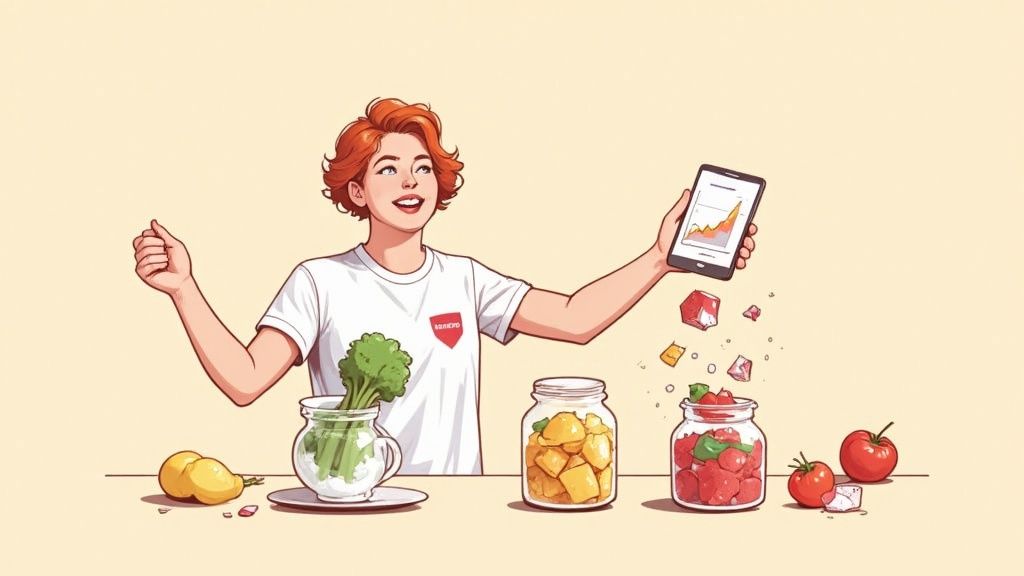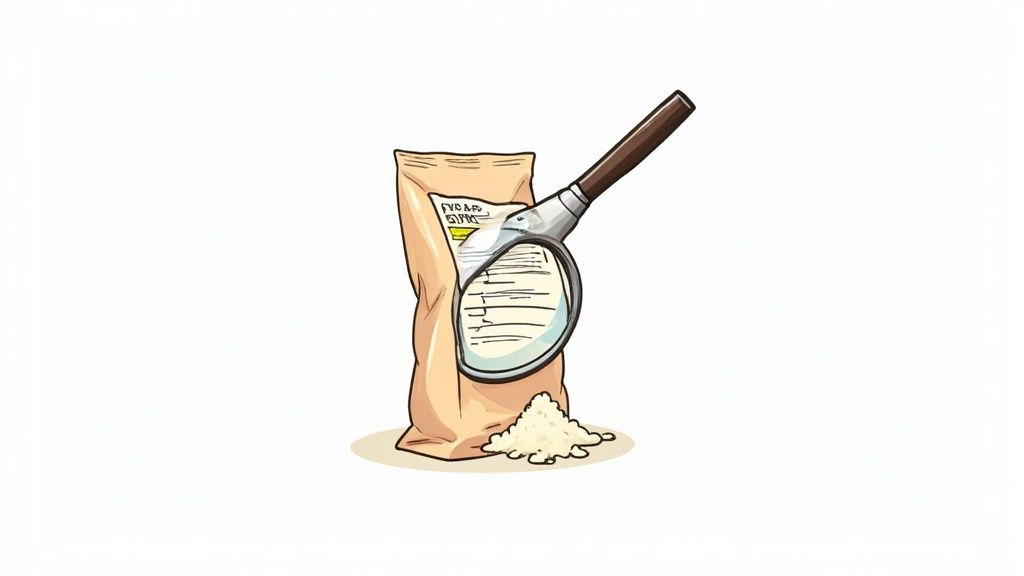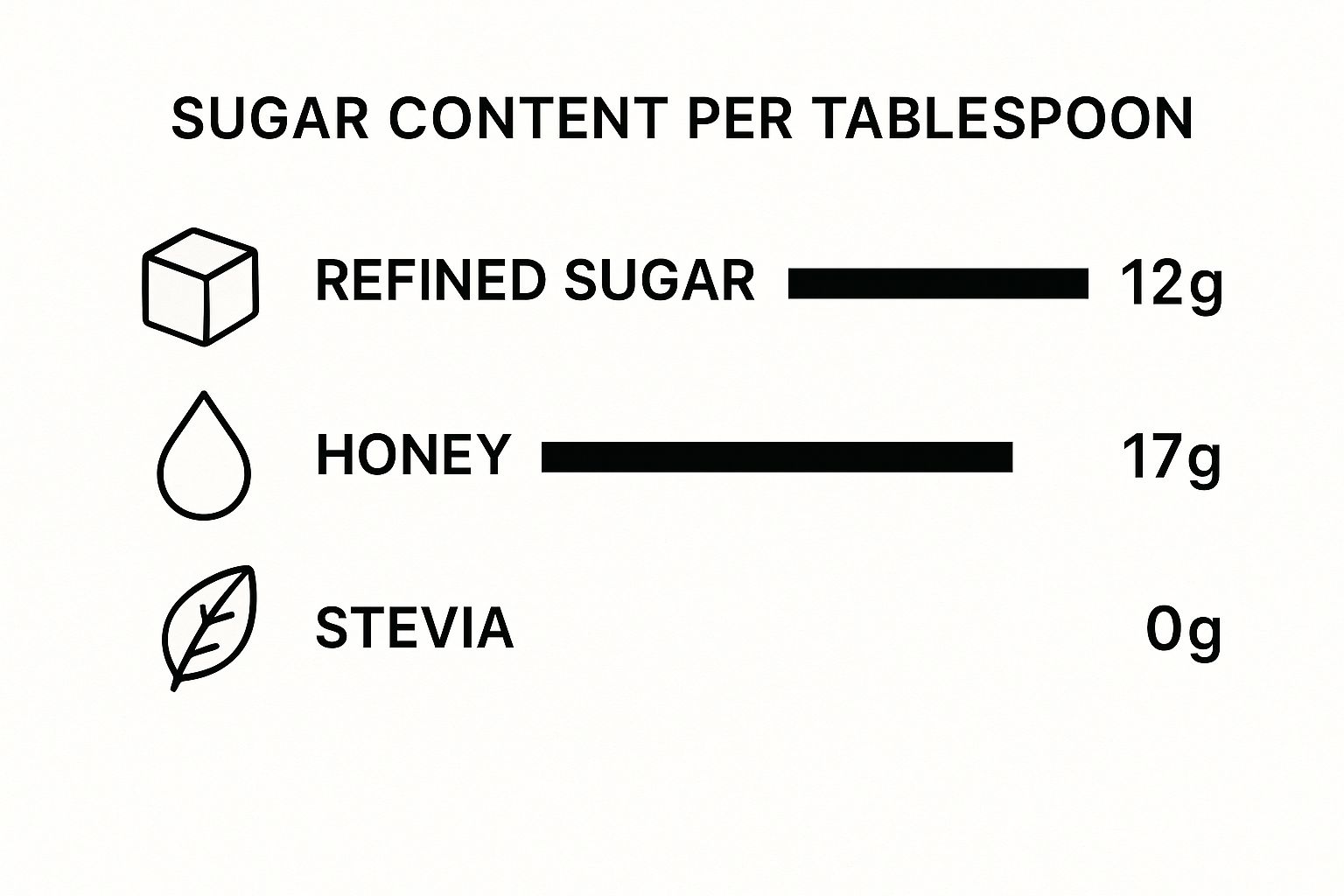How to Quit Sugar: Easy Tips for a Healthier You

Thinking about quitting sugar can feel like a huge, intimidating mountain to climb. But here's the secret most people miss: you don't have to conquer it all at once. The most successful approach isn't about a brutal, all-or-nothing detox. It's about first understanding where sugar is hiding and then making a simple, realistic plan to gradually cut back. This way, you build habits that actually stick.

Where to Realistically Begin Your Sugar-Free Journey
Let's be real. The idea of going completely sugar-free from day one is enough to make anyone give up before they even start. So many of us jump in with a strict mindset, only to crash and burn within days, battling intense cravings and feeling like a total failure. That’s because our bodies—and our daily routines—are wired for sugar in ways we often don’t even see.
The key to actually making this work is a slow and steady reduction. Think of it less like a test of willpower and more like a journey of becoming more aware. Your goal right now isn't perfection. It's just progress. Starting small creates momentum that leads to lasting change, all without that awful feeling of deprivation.
Why Taking It Slow Is the Smarter Move
Going cold turkey is a shock to your system. It can trigger withdrawal-like symptoms—headaches, exhaustion, and serious irritability. This "sugar flu" is the very thing that sends most people right back to their old habits. A gradual approach, on the other hand, gives your body and brain time to adjust without the drama.
It also does something amazing for your taste buds. As you slowly dial down the hyper-sweet, processed stuff, you start to notice the natural sweetness in real food. Suddenly, an apple tastes incredibly sweet, and a sip of soda feels almost painfully sugary.
My Two Cents: A lasting plan to quit sugar is all about awareness and gradual reduction. You're building a healthier relationship with food, not just white-knuckling your way through a restrictive diet.
Becoming a Hidden Sugar Detective
Your first real mission is to become a sugar detective. Added sugars aren't just in the obvious places like cookies and candy. They're tucked away in countless products, many of them disguised as "healthy." Learning to read nutrition labels is your single most powerful tool right now.
And it’s a real challenge. The global sugar market, valued at around USD 68.23 billion, is on track to hit USD 121.08 billion by 2033. Why? Mostly because it's a cheap and easy way to make processed foods taste good. You can read the full forecast on the growing global sugar market to see just how big the industry is. This makes it absolutely essential to know what you’re putting in your body.
Here are just a few of the most common culprits where added sugars love to hide:
- Flavored Yogurts: A small pot can have as much sugar as a chocolate bar.
- Salad Dressings: Many bottled dressings, especially the "fat-free" kinds, use sugar for flavor.
- Pasta Sauces: A single serving of jarred marinara can easily have over 10 grams of added sugar.
- Breakfast Cereals: Even the ones that don't look sugary are often loaded with it.
- Breads and Condiments: Ketchup, barbecue sauce, and even some whole-wheat breads have added sweeteners.
Start by just looking at the labels of things you eat every day. You'll probably be shocked by what you find. This isn't about feeling guilty; it's about gathering intel so you can make smarter choices.
To get you started, I've put together a quick cheat sheet of common foods with a surprising amount of hidden sugar.
Common Foods with Hidden Added Sugars
This table highlights everyday foods with surprisingly high amounts of hidden sugar, helping you identify and avoid them from day one.
| Food or Drink Category | Common Examples | Typical Sugar Content Per Serving |
|---|---|---|
| Breakfast Foods | Flavored Oatmeal Packets, Granola | 10-15 grams |
| "Healthy" Snacks | Granola Bars, Protein Bars | 8-20 grams |
| Beverages | Vitamin Waters, Iced Teas, Juices | 25-40 grams |
| Condiments & Sauces | Ketchup, BBQ Sauce, Teriyaki Sauce | 4-12 grams per tablespoon |
Use this as a starting point. Your mission for the next few days is simple: just notice. No big changes yet, just pure awareness. This is the foundation for everything that comes next.
Mastering the Mindset for a Sugar-Free Life
Let’s be honest: quitting sugar is less about what’s on your plate and more about what’s going on in your head. I’ve seen it time and time again—the real battle is mental. Relying on willpower alone is like trying to hold back the tide with a bucket. It's just not going to work long-term.
To truly succeed, you have to fundamentally shift your relationship with sugar. This isn’t about deprivation. It's about empowerment.

Think of it as building mental armor. You're developing a positive outlook that will see you through the tough moments, because there will be tough moments. This mindset shift is what turns a temporary diet into a lasting, healthy lifestyle.
Identify Your Personal Sugar Triggers
Sugar cravings don’t just pop up out of thin air. They're almost always a response to something else—a feeling, a place, a specific time of day. Your first job is to become a detective and figure out what your personal triggers are.
For the next few days, whenever a powerful sugar craving hits, just pause. Don't judge, just observe. Ask yourself a few simple questions:
- How am I feeling right now? Boredom, stress, sadness, and fatigue are huge culprits. Sugar offers a quick, easy hit of comfort when we're feeling low.
- What just happened? Did you have a fight with your partner? Did you just finish a grueling meeting at work? Or maybe you plopped down on the couch to watch TV, which has become your cue for a sweet snack.
- What time is it? That 3 p.m. slump is real. So many of us automatically reach for sugar to power through the afternoon without even thinking about it.
Once you see the patterns, you can start to break them. If stress is your trigger, what if you went for a five-minute walk instead of grabbing a cookie? If you're eating out of boredom, try calling a friend. To dig deeper into the science behind these urges, you can learn more about why we crave sugar in our detailed guide.
Practice Mindful Eating to Break Unconscious Habits
Think about the last time you ate something sweet. Were you really paying attention? Or were you scrolling through your phone, watching Netflix, or answering emails? This is what I call "mindless eating," and it's where so much of our unconscious sugar intake comes from. You can finish a whole bag of candy without truly tasting a single piece.
Mindful eating is the antidote. It’s simply the practice of bringing your full, undivided attention to the act of eating.
By practicing mindfulness at mealtimes, you can dramatically reduce unconscious sugar intake. The simple act of paying attention reconnects you with your body's true hunger and satiety signals, empowering you to make conscious choices instead of acting on autopilot.
Start small. Try it with just one meal today. Put your phone away. Turn off the TV. Focus completely on your food. Notice its colors, smells, and textures. Chew slowly and savor each bite. It might feel a little weird at first, but this one practice is incredibly powerful for breaking those old, stubborn habit loops.
Build Resilience and Celebrate Small Wins
This journey isn't going to be a perfect, straight line. There will be great days, and there will be days when you just want to eat an entire cake. That’s completely normal. The key to making this stick is to stop chasing perfection and start focusing on progress.
Set tiny, achievable goals for yourself. Maybe this week, your only goal is to swap your daily soda for sparkling water. That's it. When you do it, give yourself a pat on the back! Acknowledge the win. This builds positive momentum and helps you see yourself as someone who has control over sugar.
And if you slip up? Don't beat yourself up. One cookie doesn't undo all your hard work. Use it as a learning moment. What led to the slip? What could you do differently next time you're in that situation? This kind, analytical approach is what builds the resilience you need to stay on track for good.
How to Build Your Low-Sugar Meal Plan
Let's be real: having a plan is what separates a vague wish to "eat less sugar" from actually making it happen. A little prep work is your secret weapon. This isn't about some rigid, joyless diet; it's about setting yourself up to win so you always have a satisfying, healthy meal ready to go.
Think about it. When you’re starving and unprepared, that's when you’re most likely to grab the quickest, easiest thing—which is almost always loaded with sugar. By planning your meals, you take back control from those moments of desperation and put yourself in the driver's seat.
Become a Label-Reading Detective
Before you can even start planning, you need to know what you’re up against. Food companies are masters of disguise, hiding sugar in places you'd never think to look. It's not just in the candy aisle; it's lurking in your bread, salad dressing, and that "healthy" yogurt.
Learning to read a nutrition label is a non-negotiable skill for this journey. You have to get past the flashy claims on the front of the box and flip it over to inspect the ingredients list and the "Added Sugars" line. Sugar hides under dozens of aliases like high-fructose corn syrup, dextrose, sucrose, and barley malt. The higher up an ingredient is on the list, the more of it there is. To really get the hang of this, check out our guide on how to read nutrition labels like a pro.
Your Grocery List Blueprint
A great low-sugar week starts with a smart trip to the grocery store. Your goal is to fill your cart with whole, unprocessed foods—the kind that don't need a complicated label in the first place. You’re basically stocking your kitchen with allies for this new way of eating.
Here’s a simple framework for your shopping list:
- Lean Proteins: Think chicken breast, fish (salmon is a great choice), eggs, tofu, lentils, and beans. Protein is your best friend for feeling full and keeping blood sugar stable, which is key to crushing cravings.
- Healthy Fats: Avocados, nuts, seeds (I love chia and flax), and good old olive oil. These give you long-lasting energy and that satisfied feeling after a meal.
- Complex Carbohydrates: Quinoa, brown rice, sweet potatoes, and oats. Look for whole-grain bread, but always check the label! These break down slowly, so you avoid those nasty energy spikes and crashes.
- Vegetables and Fruits: Go wild here. Leafy greens, broccoli, bell peppers, and berries are fantastic choices packed with fiber, vitamins, and natural sweetness.
Key Insight: The magic formula for staying full and keeping cravings at bay is building your meals around protein, healthy fats, and high-fiber carbs. This powerful trio will keep you satisfied for hours.
This thoughtful approach to shopping is more important than you might think. Global sugar production is projected to reach a staggering 188.8 million tonnes—a near-historic high—with some countries increasing production by over 25%. All that cheap, abundant sugar has to go somewhere, and it often ends up in our food. If you're curious, you can discover more about global sugar production trends and see the scale of what we're up against.
Simple Meal Ideas and Prep Strategies
You don't need to be a gourmet chef to eat well. Honestly, the best low-sugar meals are often the simplest. The goal is to make healthy eating so incredibly easy that it becomes your new normal.
Easy Meal Examples:
| Meal Type | Simple Low-Sugar Ideas |
|---|---|
| Breakfast | Scrambled eggs with a handful of spinach and some avocado, or plain Greek yogurt topped with fresh berries and a sprinkle of chia seeds. |
| Lunch | A big salad with grilled chicken, lots of veggies, and a simple olive oil vinaigrette. A quinoa bowl with black beans and roasted vegetables also works great. |
| Dinner | Baked salmon with roasted sweet potatoes and steamed broccoli. Or, a big bowl of hearty lentil soup on a cool evening. |
Food prep will change your life. Seriously. Just an hour or two on a Sunday can set you up for a whole week of success. Wash and chop your veggies, cook a big batch of quinoa or brown rice, and grill a few chicken breasts. Having these building blocks ready to go means you can throw together a healthy meal in minutes, making it the easiest choice you have.
Finding Smart Swaps and Healthy Alternatives
Let's get one thing straight: quitting sugar doesn't mean your food has to be bland. Not even close. This whole process is about discovering a new world of flavor, not sentencing yourself to a tasteless existence. The real trick is learning to make smart swaps for the high-sugar foods you’re used to.
This isn't about deprivation—it's about discovery. It’s a chance to find alternatives that not only satisfy your cravings but actually nourish your body, leaving you feeling more energized and clear-headed than ever before. When you start focusing on what you can have, the whole mindset shifts from loss to gain.
Retrain Your Palate for Natural Sweetness
One of the most amazing things that happens when you cut out processed sugar is how your taste buds come back to life. Seriously. Foods you once found boring will suddenly seem packed with flavor. An apple will taste incredibly sweet, and you'll notice a satisfying, earthy sweetness in carrots that was always there, just hidden.
The first step is to lean into whole foods. Instead of grabbing a packaged "health" bar, reach for a piece of actual fruit. The fiber in whole fruit slows down how your body absorbs its natural sugars (fructose), which prevents the sharp blood sugar spikes that refined sugar causes. It’s a complete myth that you have to avoid fruit when quitting sugar; in fact, a diet rich in whole fruits is one of the best things you can do.
A Fresh Perspective: A clinical dietitian-nutritionist put it perfectly: "Eating a plant-forward diet that incorporates fruits and vegetables in their whole-food form, in practical portions, is actually a smart way to reduce the risk of cancer developing or recurring." This just goes to show that natural sweetness from whole foods are your allies, not your enemies.
Your Go-To List for Healthy Swaps
Snack time is a classic danger zone. It's usually when we're tired, stressed, or bored that we make a beeline for something quick and sugary. Having a plan with satisfying, low-sugar alternatives ready to go can be a total game-changer.
Here are a few simple swaps I personally rely on:
- Craving a candy bar? Try a small handful of almonds with a square of 70% cacao (or higher) dark chocolate. The nuts give you protein and healthy fats that keep you full, and the chocolate delivers that rich flavor without the sugar bomb.
- Reaching for sugary yogurt? Go for plain, full-fat Greek yogurt with a dash of cinnamon and a handful of fresh berries. You get the probiotics and protein without the 15-20 grams of added sugar hiding in most flavored yogurts.
- Need something crunchy like chips? Grab some bell pepper strips, cucumber slices, or celery sticks and dip them in hummus. It nails that savory crunch while giving you fiber and nutrients.
- Tempted by a muffin or pastry? A rice cake topped with natural peanut butter and a few banana slices is a great alternative. It’s the perfect combo of complex carbs, protein, and just enough natural sweetness.
The goal is to have options that satisfy both your hunger and your need for a certain texture or taste—whether that’s crunchy, creamy, or sweet.
Making these simple swaps a part of your daily life is a huge step. Here’s a quick-reference table to make those everyday choices a little easier.
Simple Sugar Swaps for Your Daily Routine
| Instead of This (High Sugar) | Try This (Low Sugar) | Why It's a Smarter Choice |
|---|---|---|
| Flavored Oatmeal Packet | Plain Rolled Oats with Berries & Nuts | Avoids added sugars and preservatives while giving you more fiber and protein to keep you full. |
| Sugary Cereal | Plain Greek Yogurt with Cinnamon | Swaps empty carbs and sugar for high-quality protein and probiotics for better gut health. |
| Soda or Sweet Tea | Sparkling Water with Lemon or Mint | Hydrates without the empty calories and blood sugar spikes. It's refreshing and has zero sugar. |
| Bottled Salad Dressing | Olive Oil & Vinegar | You control the ingredients, skipping the hidden sugars and unhealthy fats found in many commercial dressings. |
| Store-Bought Pasta Sauce | Canned Crushed Tomatoes with Herbs | Many jarred sauces contain surprising amounts of added sugar. Making your own is simple and much healthier. |
Remember, every small swap adds up to a big change in how you feel.
Navigating Natural Sweeteners
While the long-term goal is to reduce your overall need for sweetness, natural zero-calorie sweeteners can be a useful bridge, especially at the start. They can help you transition away from sugar without feeling completely deprived.
This image shows just how different sweeteners stack up when it comes to sugar content.

As you can see, sweeteners like stevia offer sweetness without any actual sugar. That makes them a much better choice than refined sugar or even honey, which packs more sugar per tablespoon.
Options like stevia and monk fruit won't spike your blood sugar, which is a huge plus. However, it's best to think of them as temporary tools, not permanent replacements. Use them to lightly sweeten your coffee or a homemade treat, but keep working on appreciating food in its natural state.
Your real goal is to get to a place where you can truly enjoy the subtle, natural sweetness found in real, whole foods. By making these smart swaps, you'll soon realize that quitting sugar is less about what you’re giving up and more about everything you stand to gain: better health, more energy, and a whole new appreciation for flavor.
How to Navigate Social Life and Prevent Relapses
Let's be real. Moving your sugar-free journey from the safety of your own kitchen out into the world of birthday parties, happy hours, and office donuts is where things get tricky. This is the ultimate test, but success isn't about becoming a hermit. It’s about building the skills and confidence to handle these situations without throwing all your hard work out the window.

The secret weapon here is a mix of preparation and perspective. Knowing what to say when your aunt offers you her famous pie or having a game plan for dinner out makes all the difference. This is your playbook for building resilience so you can live your life and stick to your goals.
Strategies for Social Events and Eating Out
Social gatherings can feel like a minefield when you're cutting out sugar. The pressure, whether it’s from well-meaning friends or just the festive vibe, is no joke. But a little bit of foresight puts you back in the driver's seat.
My number one rule? Never arrive hungry. A protein-heavy snack before you go—think a handful of almonds, some cheese, or a small Greek yogurt—blunts your appetite. Suddenly, that tray of sugary appetizers doesn't seem nearly as tempting.
Another great move is to bring a dish you know you can eat. Offer to contribute a huge, colorful salad with a simple vinaigrette or even a surprisingly delicious sugar-free dessert. This guarantees you have a safe, healthy option, and you might even open a few eyes to how good healthy food can be.
When you’re eating out, the menu is your best friend. Most restaurants have them online, so do a little recon before you go. Look for grilled proteins and veggie sides. And don’t be afraid to ask for what you need! Getting dressings or sauces on the side is a simple request that can easily save you from 15-20 grams of hidden sugar.
How to Politely Decline Sugary Foods
Saying "no" without feeling awkward is a skill, especially when someone made something special. The key is to be gracious but firm. You don't owe anyone a long-winded explanation. Keep it simple.
Here are a few of my go-to phrases that work like a charm:
- "That looks incredible, but I'll pass for now. Thanks so much for offering!" It's polite, appreciative, and closes the door to follow-up questions.
- "I'm all set, thank you! The [healthy thing you ate] was so good." This gracefully redirects the conversation to something positive you did enjoy.
- "No thanks, I'm cutting back on sweets right now, but I really appreciate it." A little bit of honesty often works perfectly.
Most people will respect your choice. If someone pushes, just calmly repeat your polite "no thanks." Your health choices are yours and yours alone.
Key Takeaway: A slip-up isn't a failure—it's just data. Instead of letting guilt send you into a spiral, use it as a learning opportunity. Figure out what triggered the moment and build a better strategy for next time. That mindset shift is the real key to lasting success.
Bouncing Back from a Relapse
Sooner or later, you're probably going to eat something sugary. It happens. The most important part of this entire journey is how you react in the moments after it happens. A single cookie doesn't undo all your progress unless you allow it to.
The real danger is the "what the heck" effect. It's that voice in your head that says, "Well, I blew it, so I might as well eat the rest of the cake." You have to learn to shut that voice down.
Here’s your game plan for getting right back on track:
- Acknowledge, Don't Judge: Okay, it happened. Don't beat yourself up or call it a failure. It was one choice. That’s it.
- Hydrate and Move On: Drink a big glass of water. Then, with your very next meal, get right back to your plan. Don't skip meals to "make up for it"—just return to your normal, balanced, low-sugar eating.
- Analyze the Trigger: Once you're calm, take a second to think. What led to the slip? Were you stressed? Unprepared for an event? Bored? Identifying your personal triggers is how you prevent it from happening again.
Understanding why these cravings hit is crucial. For a deeper dive into managing those urges, check out our guide on how to control sugar cravings. Remember, this is about creating a sustainable lifestyle, not a perfect one. Every single meal is a new chance to make a choice that serves you.
Your Questions About Quitting Sugar Answered
Taking the plunge to go low-sugar is exciting, but it almost always comes with a lot of questions. That’s perfectly normal. Feeling a little uncertain is part of the process, so I’ve pulled together some of the most common questions I hear.
My goal is to give you clear, practical answers from my experience. Knowing what to expect ahead of time makes the journey so much smoother. Think of this as your personal FAQ for building a healthier, more energized you.
How Long Does It Take to Stop Craving Sugar?
This is the big one, isn't it? The honest answer is that it’s a bit different for everyone, but there's a general pattern I've seen time and again. For most people, the really intense, can’t-think-about-anything-else cravings start to die down significantly after the first one to two weeks of being consistent.
What's happening is that your body is recalibrating. Your taste buds, which have been overwhelmed by super-sweet processed foods, finally get a chance to reset. Suddenly, you'll start noticing the natural sweetness in whole foods like a crisp apple or a roasted sweet potato.
Key Insight: A truly amazing moment on this journey is when you bite into a simple strawberry and it tastes like the sweetest candy you've ever had. That’s the proof that your palate is healing and your body is adapting. You can help this process along by staying hydrated and eating balanced meals with plenty of protein and healthy fats to keep your blood sugar from crashing.
If you find yourself in a tough spot, the StopSugar app has a "Panic Button" feature. When a craving hits hard, it gives you immediate alternatives and a dose of motivation to get you through that moment.
Will I Experience Withdrawal Symptoms?
It’s definitely possible, and it’s always better to be prepared. Many people go through what's often called the "sugar flu" when they first cut out sugar. Don't worry, it's not a real illness. It's just a collection of symptoms that signal your body is adjusting to a new way of fueling itself.
Common symptoms can include:
- Headaches: Often your body's initial reaction to not having its usual quick-energy hit.
- Fatigue: You might feel pretty sluggish as your system learns to run on more stable energy from protein and healthy fats instead of quick sugar bursts.
- Irritability: Mood swings are common. Your brain's reward pathways are literally rewiring themselves.
- Brain Fog: Feeling a bit cloudy or finding it hard to concentrate is also typical.
These symptoms usually peak around day two or three and then start to get much better. The best way to soften the blow is to drink tons of water, get plenty of rest, and focus on eating nutrient-dense food. This is not the time to restrict calories—give your body the quality fuel it needs to make the switch smoothly.
Is It Better to Quit Sugar Cold Turkey or Gradually?
While some people love the rip-the-band-aid-off approach, my experience shows that for most people, a gradual reduction is far more sustainable. Going cold turkey can be a huge shock to your system, leading to withdrawal symptoms so intense that it's easy to throw in the towel.
A gradual approach, on the other hand, helps you build lasting habits without that awful feeling of deprivation. Here’s a simple, real-world path you could follow:
- Week 1: Start by cutting out all sugary drinks. This means sodas, sweetened coffees and teas, and most fruit juices. For many, this is the single biggest source of added sugar.
- Week 2: Now, tackle the obvious sweets like desserts, candy, and pastries. Start looking for satisfying, low-sugar swaps you actually enjoy.
- Week 3 & Beyond: This is when you become a detective. Start reading labels to find the hidden sugars in things like pasta sauce, salad dressings, and even bread.
This method gives your body and mind time to adapt, making the whole thing feel like a positive choice, not a punishment.
What Are the Best Natural Sugar Substitutes?
Ultimately, the real goal is to reduce your overall need for intense sweetness. That said, natural zero-calorie sweeteners can be a fantastic tool, especially when you're just starting out. They help bridge the gap when a craving strikes but you're committed to avoiding actual sugar.
The best choices are the ones that won't send your blood sugar on a roller coaster. These include:
- Stevia: A sweetener from the stevia plant. It's incredibly sweet, so a little goes a long way.
- Monk Fruit: Another plant-based option that gets its sweetness from natural antioxidants called mogrosides.
- Erythritol: This is a sugar alcohol that has almost no impact on blood sugar.
It's important to see these as temporary helpers, not a permanent part of your diet. Use them to lightly sweeten your morning coffee or a homemade treat, but keep working on retraining your taste buds to love the subtle, natural sweetness of whole foods. That balanced mindset is the key to creating a change that truly lasts.